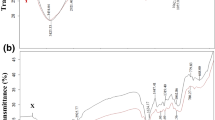Abstract
Our paper investigates the removal efficiency of toxic hexavalent chromium from aqueous solutions by the fungal strain Trichoderma viride, isolated from forest soil and exploited in the form of dead and living biomass. Our findings show that lower pH values ensure maximum removal efficiency (100%) for dead biomass, while nearly neutral pH values are suitable for Cr(VI) removal by the living microorganisms. Data processing by different kinetic models and FTIR analysis is allowed to elucidate the mechanism of Cr(VI) removal by dead T. viride as’adsorption-coupled reduction’, while the intracellular reduction is the dominating mechanism for Cr(VI) removal by living T. viride. An optimization procedure based on SADE-NN-3 alternative of the Differential Evolution (DE) algorithm allowed setting various process parameters and obtaining conditions which ensure 100% removal efficiency.
Access this chapter
Tax calculation will be finalised at checkout
Purchases are for personal use only
Similar content being viewed by others
References
Abubeah, R., Altaher, H., Khalil, T.: Removal of hexavalent chromium using two innovative adsorbents. Environ. Eng. Manage. J. 17, 1621–1634 (2018)
Gavrilescu, M.: Removal of heavy metals from the environment by biosorption. Eng. Life Sci. 4, 219–232 (2004)
Bohli, T., Ouederni, A., Villaescusa, I.: Simultaneous adsorption behavior of heavy metals onto microporous olive stones activated carbon: analysis of metal interactions. Euro-Mediterranean J. Environ. Integr. 2, 1–15 (2017). https://doi.org/10.1007/s41207-017-0030-0
Haouti, R. El, Anfar, Z., Et-Taleb, S., Benafqir, M., Lhanafi, S., Alem, N. El: Removal of heavy metals and organic pollutants by a sand rich in iron oxide. Euro-Mediterranean J. Environ. Integr. 3, (2018). https://doi.org/10.1007/s41207-018-0058-9
Alam, M.Z., Ahmad, S.: Chromium removal through biosorption and bioaccumulation by bacteria from tannery effluents contaminated soil. Clean Soil, Air, Water 39, 226–237 (2011)
Srivastava, V., Gusain, D., Bux, F., Sharma, G.C., Sharma, Y.C.: Optimization of important process parameters for the removal of Cr(VI) by a modified waste material. Environ. Eng. Manage. J. 16, 2719–2730 (2017)
Subudhi, B., Jena, D.: A differential evolution based neural network approach to nonlinear system identification. Appl. Soft Comput. 11, 861–871 (2011)
Kordos, M., Duch, W.: Variable step search algorithm for feedforward networks. Neurocomputing 71, 2470–2480 (2008)
Hlihor, R.M., Figueiredo, H., Tavares, T., Gavrilescu, M.: Biosorption potential of dead and living Arthrobacter viscosus biomass in the removal of Cr(VI): Batch and column studies. Process Saf. Environ. Prot. 108, 44–56 (2017)
Acknowledgements
This work was supported by: BRAIN project Doctoral scholarships as an investment in intelligence—ID 6681, financed by the European Social Found and Romanian Government, a grant of the Romanian National Authority for Scientific Research, CNCS—UEFISCDI, PN-III-P4-ID-PCE-2016-0683, Contract no. 65/2017 and a grant of the Romanian Ministry of Education and Research, CCCDI—UEFISCDI, project number PN-III-P2-2.1-PED-2019-2430, within PNCDI III.
Author information
Authors and Affiliations
Corresponding author
Editor information
Editors and Affiliations
Rights and permissions
Copyright information
© 2021 The Editor(s) (if applicable) and The Author(s), under exclusive license to Springer Nature Switzerland AG
About this paper
Cite this paper
Hlihor, R.M., Drăgoi, E.N., Diaconu, M., Favier, L., Curteanu, S., Gavrilescu, M. (2021). Behind the Mechanism of Chromium (VI) Removal and Reduction from Aqueous Solutions by Fungal Biomass Using a Bio-Inspired Process Modelling and Optimization. In: Ksibi, M., et al. Recent Advances in Environmental Science from the Euro-Mediterranean and Surrounding Regions (2nd Edition). EMCEI 2019. Environmental Science and Engineering(). Springer, Cham. https://doi.org/10.1007/978-3-030-51210-1_82
Download citation
DOI: https://doi.org/10.1007/978-3-030-51210-1_82
Published:
Publisher Name: Springer, Cham
Print ISBN: 978-3-030-51209-5
Online ISBN: 978-3-030-51210-1
eBook Packages: Earth and Environmental ScienceEarth and Environmental Science (R0)




